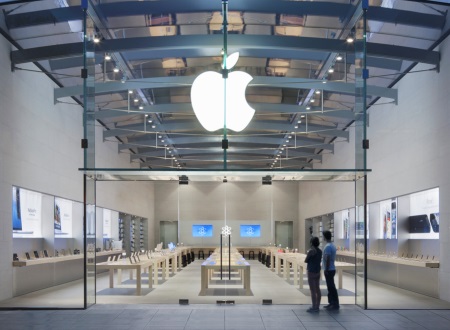Apple Inc. (NASDAQ: AAPL) has finally recovered from its crush depth lows of 2012 and 2013. Apple gained about 8% in 2013, well short of the 26.5% on the Dow Jones Industrial Average (DJIA) and more than 29% of the gain for the S&P 500. As part of our annual outlook series, 24/7 Wall St. wanted to see what Apple’s prospects are for 2014. We have generated a bullish and bearish scenario for 2014 in each major stock we follow regularly.
For starters, there are many macroeconomic and industry factors to consider when it comes to Apple. Dell has gone private, while Hewlett-Packard Co. (NYSE: HPQ) is considered a forgotten competitor that is still in turnaround mode. Apple’s woes were simply that it was running out of growth, and perhaps running out of generational changing ideas in the post-Jobs era.
Most Wall Street strategists are forecasting higher price targets for the S&P 500 and the DJIA in 2014. That should offer support for Apple, but Apple fell from its peak above $700 to about $400, even when stocks were still rising. The Federal Reserve is going to taper its bond buying under quantitative easing, and the hope is that interest rates will not rise so much as to cripple the fragile recovery. Asia and Europe seem to be exiting their recessionary conditions as well.
The outlook for Apple is complicated. The bullish scenario is that Apple has enough cash to do whatever it wants to do. That includes buyouts, dividend, stock buybacks or even something as wild as offering to make the U.S. Treasury’s interest payments for a month or two if wanted to. Now it also has that long-rumored China Mobile deal in its pocket as well.
The bearish scenario for Apple is one of reality catching up to the world’s latest and greatest growth story of this generation. Steve Jobs is gone. New product launches and innovation seem to have moved into the back seat of the car. And some reports have shown that Apple is not getting great orders from the new China Mobile deal. One analyst also said that its margin recovery was factored into the stock price. Another concern is that Apple keeps seeing analysts downgrade the stock, now that the price has risen back from when it was constantly in the penalty box.
Apple trades around $544 at the start of 2014, and the consensus analyst price target is only around $595. Apple’s 52-week range is $385.10 to $575.14, and those old $800 to $1,000 price targets seem to be history now. Carl Icahn also still wants activist actions, but he has backed off his initial onslaught because the stock has done better.
Another issue to consider is that the market cap is almost $500 billion, so it requires serious capital inflows in the stock to drive this price higher. Is 14 times expected 2014 earnings too much for the greatest growth story of this generation? It all depends on whether it can get back into a growth mode.
Thank you for reading! Have some feedback for us?
Contact the 24/7 Wall St. editorial team.





